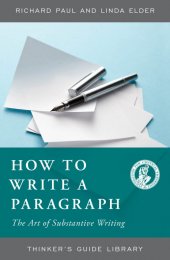How to Write a Paragraph: The Art of Substantive Writing
Contact Info for Bloomsbury:
- For questions about orders you have already placed, email weborders@mpsvirginia.com or telephone 888-330-8477, ext. 7527.
- For questions about eBook purchases or pre-orders, email contact@bloomsbury.com.
- For general enquiries not related to online orders, call 1 212-419-5300 or email contact@bloomsbury.com.
Though close reading and substantive writing are essential skills for the educated person, they are frequently ignored in education. How to Write a Paragraph applies critical thinking tools to the process of writing to guide students towards developing clear, effective, and meaningful written communication.
As a companion to How to Read a Paragraph, this volume in the Thinker’s Guide Library includes activities to sharpen writing skills and overall reasoning abilities. Readers who work through this guide learn to be clearer, more purposeful, more aware of the assumptions guiding their thoughts, and more substantive in their approach to writing.
As part of the Thinker’s Guide Library, this book advances the mission of the Foundation for Critical Thinking to promote fairminded critical societies through cultivating essential intellectual abilities and virtues across every field of study across world.
Pages: 56 • Trim: 5 3/4 x 8
978-0-944583-22-7 • Paperback • January 2013
978-1-5381-3386-6 • eBook • June 2019
Series:
Thinker's Guide Library
$25.20
Additional Information About:
How to Write a Paragraph: The Art of Substantive Writing
Skilled writers do not write blindly, but purposely. They have an agenda, goal, or objective. Their purpose, together with the nature of what they are writing (and their situation), determines how they write. They write in different ways in different situations for different purposes. There is also a nearly universal purpose for writing, and that is to say something worth saying about something worth saying something about.
In general, then, when we write, we translate inner meanings into public words. We put our ideas and experiences into written form. Accurately translating intended meanings into written words is an analytic, evaluative, and creative set of acts. Unfortunately, few people are skilled in this work of translation. Few are able to select and combine words that, so combined, convey an intended meaning to an audience of readers.
At present students are poor writers, not because they are incapable of learning to write well, but because they have never been taught the foundations of substantive writing. They lack intellectual discipline as well as strategies for improving their writing. This is true on the one hand because teachers often lack a clear theory of the relationship between writing and learning and, on the other, are concerned with the time involved in grading written work.
This guide provides techniques that enhance student learning and foster the ability to communicate clearly and logically what one is learning.
The development of writing abilities, as well as all other intellectual abilities, occurs only through sound theory and routine practice. When students understand the relationship between learning and writing, and are engaged in routine writing practice using the tools of critical thinking, they are able to learn content at deeper and deeper levels, and gradually improve their ability to communicate important ideas.
Contents include:
The Theory
- The Premise of This Guide
- Writing for a Purpose
- Substantive Writing
- The Problem of Impressionistic Writing
- Writing Reflectively
- Writing as Exercise for the Mind
- How to Write a Sentence
- Writing to Learn
- Substantive Writing in Content Areas
- Relating Core Ideas to Other Core Ideas
- Writing Within Disciplines
- The Work of Writing
- Questioning as We Write
- Non-Substantive Writing
The Practice: Exercises in Substantive Writing
- Introduction
- Paraphrasing
- Sample Paraphrases
- Paraphrasing Short Quotes
- Paraphrasing and Clarifying Substantive Texts
- Man’s Search for Meaning, by Viktor E. Frankl
- History of the Great American Fortunes, by Gustavus Myers
- On Liberty, by H. L. Mencken
- Exploring Conflicting Ideas
- Exploring Key Ideas Within Disciplines
- Analyzing Reasoning
- Evaluating Reasoning
Appendix A: The Logic of an Article
Appendix B: Evaluating an Author’s Reasoning
Appendix C: Mapping Sentences (for Instructors)
Appendix D: How to Teach Students to Assess Writing (for Instructors))
Appendix E: The Function of Transitional Words
